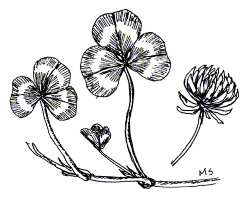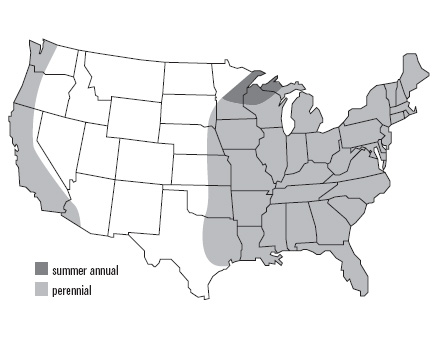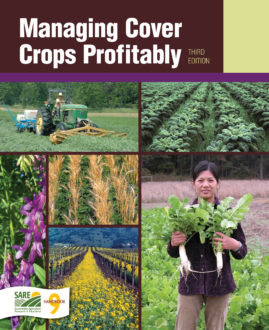
White Clover (Trifolium repens)
Also called: Dutch White, New Zealand White, Ladino
Type: long-lived perennial or winter annual legume
Roles: living mulch, erosion protection, green manure, beneficial insect attraction
Mix with: annual ryegrass, red clover, hard fescue or red fescue
See charts for ranking and management summary.
White clovers are a top choice for “living mulch” systems planted between rows of irrigated vegetables, fruit bushes or trees. They are persistent, widely adapted perennial nitrogen producers with tough stems and a dense shallow root mass that protects soil from erosion and suppresses weeds. Depending on the type, plants grow just 6 to 12 inches tall, but thrive when mowed or grazed. Once established, they stand up well to heavy field traffic and thrive under cool, moist conditions and shade.
Three types: Cultivars of white clover are grouped into three types by size. The lowest growing type (Wild White) best survives heavy traffic and grazing. Intermediate sizes (Dutch White, New Zealand White and Louisiana S-1) flower earlier and more profusely than the larger types, are more heat-tolerant and include most of the economically important varieties. The large (Ladino) types produce the most N per acre of any white types, and are valued for forage quality, especially on poorly drained soil. They are generally less durable, but may be two to four times taller than intermediate types.
Intermediate types of white clover include many cultivated varieties, most originally bred for forage. The best of 36 varieties tested in north-central Mississippi for cover crop use were Aran, Grassland Kopu and Kitaooha. These ranked high for all traits tested, including plant vigor, leaf area, dry matter yield, number of seed-heads, lateness of flowering and upright stems to prevent soil contact. Ranking high were Angel Gallardo, California Ladino and widely used Louisiana S-1 (392).
White clover performs best when it has plenty of lime, potash, calcium and phosphorus, but it tolerates poor conditions better than most clovers. Its perennial nature depends on new plants continually being formed by its creeping stolons and, if it reaches maturity, by reseeding.
White clover is raised as a winter annual in the South, where drought and diseases weaken stands. It exhibits its perennial abilities north through Hardiness Zone 4. The short and intermediate types are low biomass producers, while the large ladino types popular with graziers can produce as much biomass as any clover species.
Benefits of White Clover Cover Crops

Fixes N. A healthy stand of white clover can produce 80 to 130 lb. N/A when killed the year after establishment. In established stands, it also may provide some N to growing crops when it is managed as a living mulch between crop rows. Because it contains more of its total N in its roots than other legumes, partial tilling is an especially effective way to trigger N release. The low C:N ratio of stems and leaves causes them to decompose rapidly to release N.
Tolerates traffic. Wherever there’s intensive field traffic and adequate soil moisture, white clover makes a good soil covering that keeps alleyways green. It reduces compaction and dust while protecting wet soil against trauma from vehicle wheels. White clover converts vulnerable bare soil into biologically active soil with habitat for beneficial organisms above and below the soil surface.
Premier living mulch. Their ability to grow in shade, maintain a low profile, thrive when repeatedly mowed and withstand field traffic makes intermediate and even short-stemmed white clovers ideal candidates for living mulch systems. To be effective, the mulch crop must be managed so it doesn’t compete with the cash crop for light, nutrients and moisture. White clover’s persistence in the face of some herbicides and minor tillage is used to advantage in these systems (described below) for vegetables, orchards and vineyards.
Value-added forage. Grazed white clover is highly palatable and digestible with high crude protein (about 28 percent), but it poses a bloat risk in ruminants without careful grazing management practices.
Spreading soil protector. Because each white clover plant extends itself by sending out root-like stolons at ground level, the legume spreads over time to cover and protect more soil surface. Dropped leaves and clipped biomass effectively mulch stolons, encouraging new plants to take root each season. Reseeding increases the number of new plants if you allow blossoms to mature.
Fits long, cool springs. In selecting a fall-seeded N-producer, consider white clover in areas with extended cool springs. MERIT ladino clover was the most efficient of eight major legumes evaluated in a Nebraska greenhouse for N2 fixed per unit of water at 50° F. Ladino clover, as well as hairy vetch and fava beans (Vicia faba) were the only legumes to grow well at the 50° F temperature (334).
Overseeded companion crop. Whether frostseeded in early spring into standing grain, broadcast over vegetables in late spring or into sweet corn in early summer, white clover germinates and establishes well under the primary crop. It grows slowly while shaded as it develops its root system, then grows rapidly when it receives more light.
Management of White Clover Cover Crops
Establishment & Fieldwork for White Clover Cover Crops
Widely adapted. White clover can tolerate wet soil—even short flooding—and short dry spells, and survives on medium to acid soils down to pH 5.5. It volunteers on a wider range of soils than most legumes, but grows better in clay and loam soils than on sandy soils (120). Ladino prefers sandy loam or medium loam soils.
Use higher seeding rates (5 to 9 lb./A drilled, 7 to 14 lb./A broadcast) when you overseed in adverse situations caused by drought, crop residue or vegetative competition. Drill 4 to 6 lb./A when mixing white clover with other legumes or grasses to reduce competition for light, moisture and nutrients.
Frostseeding of small-seeded clovers (such as alsike and white) should be done early in the morning when frost is still in the soil. Later in the day, when soil is slippery, stand establishment will be poor. Frostseed early enough in spring to allow for several freeze-thaw cycles.
Late-summer seeding must be early enough to give white clover time to become well established, because fall freezing and thawing can readily heave the small, shallow-rooted plants. Seeding about 40 days before the first killing frost is usually enough time. Best conditions for summer establishment are humid, cool and shaded (120, 361). Legumes suffer less root damage from frost heaving when they are planted with a grass.
In warmer regions of the U.S. (Zone 8 and warmer), every seeding should be inoculated. In cooler areas, where N-fixing bacteria persist in the soil for up to three years, even volunteer wild white clover should leave enough bacteria behind to eliminate the need for inoculation (120).
Mowing no lower than 2 to 3 inches will keep white clover healthy. To safely overwinter white clover, leave 3 to 4 inches (6 to 8 inches for taller types) to prevent frost damage.
Clovers Build Soil, Blueberry Production
In the heart of blueberry country in the leading blueberry state in the U.S., Richard James “RJ” Rant and his mother, Judy Rant, are breaking new ground and reaping great rewards. Thanks to cover crops such as white and crimson clover taking center stage on their two family farms, the blueberry crop is thriving and the farmers are reaping significant rewards.
The Rants’ soil is also on the receiving end of the multiple benefits of white and crimson clover cover crops.
Judy and her husband, Richard Rant, planted their first bushes in the early 1980s while both were still working full time off the farm. They managed the farm until retirement without going into debt—something of an accomplishment during that period—but the operation never really took off. Still in high school when his father passed away, RJ Rant stepped into the operation during college.
Choosing farming over graduate school, RJ began a quest to improve the blueberry operation and its bottom line. His focus on soil-building and cover crops proved key to the success of their operation, now expanded to two farms: Double-R Blueberry Farm and Wind Dancer Farms, jointly operated by RJ and his mother, Judy.
Michigan blueberry farmers have been using cover crops for many years, and top producing Ottawa County farmers are no exception. Growing blueberry bushes on ten-foot centers, there is a lot of space between rows that farmers try to manage as economically and efficiently as possible. Seeking something that will not compete with the cash crop, most farmers choose rye or sod. Both require significant management in terms of time and labor, not to mention seed and fuel costs to plant and kill.
RJ Rant took a different tack. Their sandy loam soils were decent but not excellent, and his research led him to focus his efforts on improving the soil by reducing tillage and planting cover crops. While rye, an annual cover crop, required tillage in fall before planting and in spring to kill and incorporate, perennial white clover could be grown for two or more years without tilling. Because it is low-growing, the clover required less labor in planting and mowing.
“There are so many positive things I could say about cover crops,” Rant says. “The reason I keep using them is because they save me time and money.”
Although he started his research and planted his first Alsike clover crop on his own, RJ soon found research partners at Michigan State University. He cooperates with researcher Dale Mutch to fine-tune cover crop selection, planting methods and management options.
“I get really excited when I think about improving my soils,” Rant says. I see my fields as one unified system, and the biology of the soil in the inter-rows is as important as the soil and fertility up and down my blueberry rows.”
Early screening of different cover crops led Rant to further test crimson clover, a winter annual cover crop that not only grows well in fall and spring, but also shows great potential to reseed itself, further reducing costs. They have also tested red clover, small white clover, mustard, rye and spring buckwheat. Rant says white clover is his favorite because it is low growing and out-competes weeds.
Soil-building remains a primary objective of Rants cover crop program. Compacted soils are a problem for blueberries, which prefer loose, friable soil. To build better soil structure, Rant is working with MSU’s Mutch to improve soil organic matter with cover crop mulches and manures.
Mutch and Rant are studying crimson clover reseeding, another cost-saving measure, comparing mowing and tilling the crimson clover after it has set seed. They are also studying pH ranges for the clovers, which prefer a higher pH than the blueberry cash crop.
Mutch and Michigan State researcher Rufus Isaacs are helping to elucidate other management aspects of clover cover crops, such as whether honeybees and native bees such as mason bees and sweat bees are attracted to clovers.
“The clovers work really well for blueberry production, rather than needing to fit system to cover crop. If you really want to do this, you can make it work,” says RJ.
—Andy Clark
Killing White Clover Cover Crops
Thorough uprooting and incorporation by chisel or moldboard plowing, field cultivating, undercutting or rotary tilling, or—in spring—use of a suitable herbicide will result in good to excellent kill of white clover. Extremely close mowing and partial tillage that leaves any roots undisturbed will suppress, but not kill, white clover.
Pest Management for White Clover Cover Crops
Prized by bees. Bees work white clover blossoms for both nectar and pollen. Select insect management measures that minimize negative impact on bees and other pollinators. Michigan blueberry growers find that it improves pollination, as does crimson clover (see Clovers Build Soil, Blueberry Production.
Insect/disease risks. White clovers are fairly tolerant of nematodes and leaf diseases, but are susceptible to root and stolon rots. Leading insect pests are the potato leafhopper (Empoasca fabae), meadow spittlebug (Philaenis spumarius), clover leaf weevil (Hypera punctata), alfalfa weevil (Hypera postica) and Lygus bug (Lygus spp.).
If not cut or grazed to stimulate new growth, the buildup of vegetation on aged stolons and stems creates a susceptibility to disease and insect problems. Protect against pest problems by selecting resistant cultivars, rotating crops, maintaining soil fertility and employing proper cutting schedules (361).
Crop Systems for White Clover Cover Crops
Living mulch systems. As a living mulch, white clover gives benefits above and below ground while it grows between rows of cash crops, primarily in fruits, vegetables, orchards and vineyards. Living mulch has not proved effective in agronomic crops to this point. To receive the multiple benefits, manage the covers carefully throughout early crop growth—to keep them from competing with the main crop for light, nutrients, and especially moisture—while not killing them. Several methods can do that effectively.
Hand mowing/in-row mulch. Farmer Alan Matthews finds that a self-propelled 30-inch rotary mower controls a clover mix between green pepper rows in a quarter-acre field. He uses 40-foot wide, contour strip fields and the living mulch to help prevent erosion on sloping land near Pittsburgh, Pa. In his 1996 SARE on-farm research, he logged $500 more net profit per acre on his living mulch peppers than on his conventionally produced peppers (259).
Matthews mulches the transplants with hay, 12 inches on each side of the row. He hand-seeds the cover mix at a heavy 30 lb./A between the rows. The mix is 50 percent white Dutch clover, 30 percent berseem clover, and 20 percent HUIA white clover, which is a bit taller than the white Dutch. He mows the field in fall, then broadcasts medium red clover early the next spring to establish a hay field and replace the berseem, which is not winter hardy (259).
New Zealand white clover provided good weed control for winter squash in the wetter of two years in a New York trial. It was used in an experimental non-chemical system relying on over-the-row compost for in-row weed control. Plants were seeded into tilled strips 16 inches wide spaced 4 feet apart. Poor seed establishment and lagging clover growth in the drier year created weed problems, especially with perennial competitors. The living mulch/compost system yielded less than a conventionally tilled and fertilized control both years, due in part to delayed crop development from the in-row compost (282).
The research showed that in dry years, mowing alone won’t suppress a living mulch enough to keep it from competing for soil moisture with crops in 16-inch rows. Further, weeds can be even more competitive than the clover for water during these dry times (282).
A California study showed that frequent mowing can work with careful management. A white clover cover reduced levels of cabbage aphids in harvested broccoli heads compared with clean cultivated broccoli. The clover-mulched plants, in strip-tilled rows 4 inches wide, had yield and size comparable to clean cultivated rows. However, only intensive irrigation and mowing prevented moisture competition. To be profitable commercially, the system would require irrigation or a less thirsty legume, as well as field-scale equipment able to mow between several rows in a single pass (93).
Chemical suppression is unpredictable. An application rate that sets back the clover sufficiently one year may be too harsh (killing the clover) or not suppressive the next year due to moisture, temperature or soil conditions.
Partial rotary tillage. In a New York evaluation of mechanical suppression, sweet corn planting strips 20 inches wide were rotary tilled June 2 into white clover. Although mowing (even five times) didn’t sufficiently suppress clover, partial rotary tilling at two weeks after emergence worked well. A strip of clover allowed to pass between the tines led to ample clover regrowth. A surge of N within a month of tilling aided the growing corn. The loss of root and nodule tissue following stress from tillage or herbicide shock seems to release N from the clover. Leaf smut caused less problem on the living-mulch corn than on the clean-cultivated check plot (170).
Crop shading. Sweet corn shading can hold white clover in check when corn is planted in 15-inch rows and about 15 inches apart within the row. This spacing yielded higher corn growth rates, more marketable ears per plant and higher crop yields than conventional plots without clover in an Oregon study. Corn was planted into tilled strips 4 to 6 inches wide about the same time the clover was chemically suppressed. Adapted row-harvesting equipment and handpicking would be needed to make the spacing practical (139).
Unsuppressed white Dutch clover established at asparagus planting controlled weeds and provided N over time to the asparagus in a Wisconsin study, but reduced yield significantly. Establishing the clover in the second year or third year of an asparagus planting would be more effective (312).
Other Options for White Clover Cover Crops
Seed crop should be harvested when most seed heads are light brown, about 25 to 30 days after full bloom.
Intermediate types of white clover add protein and longevity to permanent grass pastures without legumes. Taller ladino types can be grazed or harvested. Living mulch fields can be overseeded with grasses or other legumes to rotate into pasture after vegetable crops, providing IPM options and economic flexibility.
Comparative Notes
- White clover is less tolerant of basic soils above pH 7 than are other clovers.
- In a Wisconsin comparison, ladino clover biomass was similar to mammoth red clover when spring-seeded (402).
- White clover stores up to 45 percent of its N contribution in its roots, more than any other major legume cover crop.
- Ladino and alsike are the best hay-type legumes on poorly drained soils. Spring growth of fall-seeded white clover begins in mid-May in the Midwest, about the same time as alfalfa.
